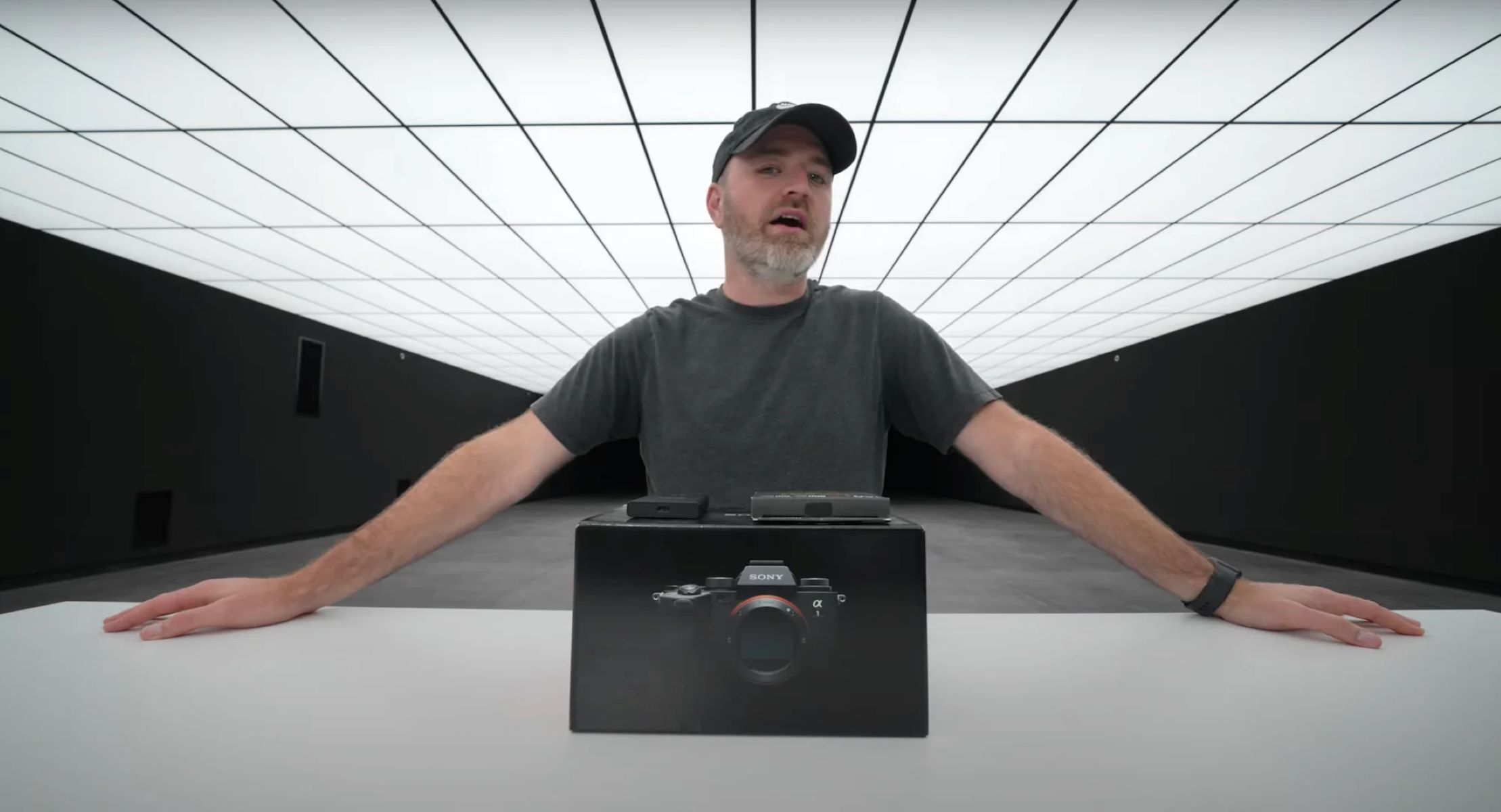Home>Production & Technology>Background Music>What Is The Purpose Of Background Music


Background Music
What Is The Purpose Of Background Music
Modified: January 22, 2024
Discover the purpose of background music and how it enhances various experiences. Explore its impact on films, commercials, and more.
(Many of the links in this article redirect to a specific reviewed product. Your purchase of these products through affiliate links helps to generate commission for AudioLover.com, at no extra cost. Learn more)
Table of Contents
- Introduction
- Background Music in Movies
- Background Music in TV Shows
- Background Music in Commercials
- Background Music in Video Games
- Background Music in Public Spaces
- Background Music in Elevators
- Background Music in Restaurants
- Background Music in Retail Stores
- Background Music in Workplaces
- Background Music in Gyms
- Background Music in Hotels
- Conclusion
Introduction
Background music is a powerful tool that has the ability to enhance our experiences in various settings. Whether it’s in movies, TV shows, commercials, video games, public spaces, elevators, restaurants, retail stores, workplaces, gyms, or hotels, background music plays a crucial role in creating the desired atmosphere and evoking specific emotions. It serves as a supporting element that adds depth, mood, and context to visual and physical environments.
The purpose of background music goes beyond simply providing a pleasant auditory backdrop. It has the potential to grab our attention, influence our moods, and even dictate our behavior. When used effectively, it can create a cohesive and immersive experience that captivates audiences and leaves a lasting impression.
In this article, we will explore the different purposes of background music in various contexts. From its role in storytelling and setting the tone in movies and TV shows, to its ability to engage consumers and enhance brand messages in commercials, to its impact on gameplay and immersion in video games, background music has a profound impact on our everyday experiences. We will also delve into its role in enhancing the ambiance in public spaces, elevators, restaurants, retail stores, workplaces, gyms, and hotels, and how it influences our interactions and perception of these environments.
So, join us as we dive deeper into the world of background music and discover the myriad of ways it enriches our lives. We’ll explore the creative techniques employed by composers, the psychological effects it has on us, and the practical applications that make background music an indispensable tool for transforming our physical and digital surroundings.
Background Music in Movies
Background music in movies serves a crucial role in shaping the overall cinematic experience. It enhances the emotional impact of a scene, builds tension, and guides the audience’s emotions. From the suspenseful notes that accompany a thrilling chase to the tender melodies that tug at our heartstrings, background music is instrumental in creating an immersive and captivating movie-watching experience.
One of the primary purposes of background music in movies is to evoke specific emotions and help tell the story. It sets the tone for a particular scene, signaling to the audience what to expect and how to feel. For instance, a slow and melancholic melody might be used in a dramatic scene to evoke sadness or longing, while an upbeat and energetic score can create a sense of excitement or joy in an action sequence.
In addition to enhancing emotions, background music in movies also helps to establish the time period and setting. For period films, composers often incorporate music that reflects the era in which the story takes place, helping to transport viewers to a different time and place. This attention to detail adds depth to the storytelling and enhances the authenticity of the cinematic experience.
Furthermore, background music can serve as a narrative device, highlighting important plot points or character development. A recurring theme or motif associated with a particular character can provide insight into their personality or foreshadow their actions. It can also be used to create suspense and build tension, heightening the anticipation of pivotal moments in the plot.
The technical aspects of background music in movies are equally important. Composers work closely with directors and editors to ensure that the music aligns seamlessly with the visuals, paying attention to cues such as dialogue, action sequences, and dramatic pauses. Properly timed and synchronized music adds depth and intensity to the on-screen events, creating a more immersive and engaging viewing experience for the audience.
In summary, background music in movies is essential for setting the mood, enhancing emotions, establishing the time and place, and advancing the narrative. It is a powerful tool that allows filmmakers to craft a more impactful and memorable cinematic experience. The careful selection and composition of background music play a significant role in creating a cohesive and immersive world that invites viewers to suspend their disbelief and become fully engrossed in the story unfolding on the screen.
Background Music in TV Shows
Background music in TV shows plays a crucial role in creating the desired atmosphere, enhancing storytelling, and engaging the audience. It serves as a powerful tool that helps set the tone, build tension, and cue emotional responses. Whether it’s a thrilling crime drama, a lighthearted sitcom, or a gripping suspense series, background music adds depth and richness to the television viewing experience.
One of the primary purposes of background music in TV shows is to establish the mood and enhance the emotional impact of a scene. It can help create a sense of anticipation, excitement, or melancholy, depending on the narrative and the desired effect. Just like in movies, background music in TV shows is carefully selected or composed to evoke specific emotions and immerse the audience in the story.
In addition to enhancing emotions, background music in TV shows also helps in character development. It can provide insights into the personalities and motivations of the characters, emphasizing their growth or highlighting their flaws. By associating certain themes or motifs with a particular character or group, the music aids in establishing their identity and adds depth to their portrayal on screen.
Moreover, background music in TV shows serves as a narrative tool, guiding the audience’s attention and emphasizing key moments or plot twists. It helps in building suspense, creating dramatic effect during revelations or cliffhangers, and heightening the impact of pivotal scenes. The carefully timed and synchronized music enhances the storytelling and keeps the viewers engaged, adding dynamic layers to the overall viewing experience.
Another important aspect of background music in TV shows is its ability to create a sense of continuity and familiarity. By using recurring musical themes or motifs, the audience can easily identify a particular show or recognize individual characters. These musical cues provide a comforting and immersive experience for fans and contribute to the overall brand identity of the TV show.
In summary, background music in TV shows serves multiple purposes, including setting the mood, enhancing emotions, aiding character development, emphasizing key moments, and creating a sense of continuity. It is a powerful tool that enriches the storytelling and adds depth to the television viewing experience. The careful selection and composition of background music contribute to the overall narrative and create a connection between the audience and the story unfolding on their screens.
Background Music in Commercials
Background music in commercials plays a crucial role in capturing the attention of viewers, enhancing brand messages, and creating emotional connections. It serves as a powerful tool in the advertising industry, helping to engage audiences, evoke specific emotions, and differentiate brands from their competitors. Whether it’s a catchy jingle, a carefully selected popular song, or a custom-composed score, background music plays a vital role in influencing consumers’ perception and response to commercials.
One of the primary purposes of background music in commercials is to grab and maintain the attention of viewers. It sets the tone for the commercial, creating an immediate emotional response that captures the audience’s interest. Catchy tunes or hooks can help increase brand recall by creating a memorable association with the product or service being advertised. The right music can make a commercial instantly recognizable and create a strong impact within a short timeframe.
In addition to grabbing attention, background music in commercials helps convey brand messages and create emotional connections with the audience. The choice of music can evoke specific emotions that align with the desired brand image or campaign message. For example, uplifting and energetic music may be used to evoke a sense of joy and enthusiasm for a product, while soothing and calming music may be used to create a sense of relaxation and comfort. The music serves as a bridge between the brand and the audience, helping to establish a connection and leave a lasting impression.
Furthermore, background music in commercials can help shape the overall brand identity and differentiate it from competitors. The style, genre, and mood of the music can reflect the brand’s personality and values. Whether it’s a youthful and vibrant sound for a trendy fashion brand or a sophisticated and elegant melody for a luxury product, the music becomes an integral part of the brand’s communication strategy, helping to create a distinct and recognizable audio identity.
The strategic placement and synchronization of background music with the visuals and narrative of a commercial are of utmost importance. The music should complement and enhance the visuals, reinforcing the messaging and creating a seamless and cohesive experience for the viewer. The tempo and rhythm of the music can also be synchronized with the pacing of the commercial, adding an extra layer of engagement and effectiveness.
In summary, background music in commercials plays a vital role in capturing attention, conveying brand messages, creating emotional connections, and differentiating brands. It is a powerful tool that advertisers utilize to engage audiences, evoke specific emotions, and leave a lasting impression. The strategic selection and integration of background music in commercials contribute to the overall effectiveness and success of advertising campaigns.
Background Music in Video Games
Background music in video games is a crucial element that enhances gameplay, sets the atmosphere, and immerses players in the virtual worlds they explore. It serves as a powerful tool that heightens emotions, guides gameplay, and creates memorable experiences. From epic orchestral scores to dynamic electronic beats, the music in video games plays a significant role in enhancing the overall gaming experience.
One of the primary purposes of background music in video games is to set the mood and atmosphere. It can transport players to different worlds, whether it’s a serene and peaceful forest, an ominous and foreboding dungeon, or a fast-paced and action-packed battlefield. The music helps establish the tone of the game, influencing players’ emotions and enhancing their immersion in the virtual environment.
Background music in video games also aids in building tension and creating a sense of anticipation. As players progress through different levels or face challenging boss battles, the music adapts to reflect the increasing intensity of the gameplay. It enhances the dramatic moments, signaling key events and heightening the adrenaline rush experienced by players. The music can dynamically change to match the action, adding an extra layer of excitement and engagement.
In addition to setting the mood and enhancing gameplay, background music in video games also helps in storytelling and character development. By associating specific musical themes with characters or locations, the music reinforces their identities and adds depth to their narratives. It can evoke emotions tied to specific story beats, making the player emotionally invested in the game world and its inhabitants.
Furthermore, background music in video games needs to be interactive and responsive to the player’s actions. Adaptive music systems allow the music to seamlessly transition between different tracks or layers, depending on the player’s choices or in-game events. This adaptive nature of video game music adds a level of immersion, making the player feel like an active participant in shaping the soundtrack to their own gameplay experience.
The quality and composition of background music in video games are equally important. Game composers work closely with developers to create a score that complements and enhances the gameplay experience. They consider factors like pacing, intensity, and thematic coherence to ensure that the music holistically aligns with the game’s design and mechanics.
In summary, background music in video games serves multiple purposes, including setting the mood, enhancing gameplay, aiding storytelling, and adding an interactive layer to the overall experience. The carefully crafted music contributes to the immersion and enjoyment of players, elevating the gaming experience to new heights. Whether it’s the orchestral grandeur of an RPG or the pulse-pounding beats of a fast-paced shooter, background music in video games plays a vital role in creating memorable and captivating gaming experiences.
Background Music in Public Spaces
Background music in public spaces is an essential element that helps create a welcoming and engaging environment for visitors. From shopping malls to airports, from museums to theme parks, background music plays a significant role in shaping the overall atmosphere and enhancing the experience of the space. It serves as a subtle yet impactful tool that influences the mood, behavior, and perception of individuals in these public settings.
One of the primary purposes of background music in public spaces is to create a pleasant and comfortable ambiance. Well-chosen music can help reduce stress, mask unwanted noise, and contribute to a relaxing and enjoyable environment. This is particularly important in busy areas where people may be feeling overwhelmed or anxious. The right selection of music can have a calming effect, making public spaces more inviting and comfortable for visitors.
Background music in public spaces also helps in setting the pace and rhythm of movement. In areas like shopping malls or retail stores, the music can be selected to encourage a leisurely browsing experience, prompting customers to spend more time and explore the available offerings. In contrast, in transportation hubs like airports or train stations, the music might have a more energetic tempo to keep people moving and ensure efficient navigation through the space.
Moreover, background music in public spaces contributes to the branding and identity of the location. The choice of music can reflect the values, target audience, or theme of the space. For instance, a high-end boutique may incorporate sophisticated and elegant music to align with its luxury image, while a family-friendly theme park may play upbeat and lively tunes to enhance the festive atmosphere. The music becomes a part of the overall customer experience and reinforces the brand’s messaging.
Background music also has the power to influence behavior in public spaces. Upbeat and energetic music can elevate mood and create a positive atmosphere, motivating people to be more active and engage in social interactions. In contrast, softer and more subdued melodies may encourage a calm and reflective mood in areas like libraries or art galleries, where silence and contemplation are desired.
Furthermore, background music can enhance thematic experiences in specific areas, such as historical sites or museums. By selecting or composing music that aligns with the era or subject matter, the ambiance can be enriched, creating a more immersive and educational experience for visitors.
In summary, background music in public spaces serves multiple purposes, including creating a pleasant ambiance, influencing behavior, enhancing branding, and setting the tone and rhythm of movement. The careful selection and composition of music contribute to the overall experience and play an integral role in shaping the perception and enjoyment of individuals in these public settings.
Background Music in Elevators
Background music in elevators serves a specific purpose in creating a pleasant and comfortable atmosphere for passengers during their short yet often mundane journeys. It plays a significant role in enhancing the overall elevator experience by adding a touch of ambiance and reducing any potential awkward silence. While often subtle and unobtrusive, the background music in elevators can contribute to a more enjoyable and relaxing ride.
One of the primary purposes of background music in elevators is to create a soothing and calming effect. The gentle melodies or soft instrumental tracks can help passengers feel at ease and distract them from any potential discomfort or anxiety associated with being in a confined space. Elevator music is carefully selected to add a touch of relaxation to the journey, making it more pleasant and enjoyable for passengers.
Background music in elevators also serves as a means to enhance or mask any unsettling or unwanted noises that could occur during the ride. The low volume of the music can help muffle sounds such as mechanical noises, footsteps, or conversations happening in close proximity. By providing a peaceful background soundtrack, the music ensures a more pleasant acoustic environment, reducing any feelings of awkwardness or discomfort.
Moreover, background music in elevators can contribute to the branding or image of the building or establishment. In some cases, the music selection may align with the ambiance or theme of the overall space. For example, in a luxury hotel, the background music might reflect an elegant and sophisticated atmosphere, while in a corporate office building, it might aim for a more professional and contemporary vibe. The music becomes another element to enhance the overall experience and reinforce the desired image or perception.
In addition to ambiance and branding, the choice of background music in elevators can also influence the perceived speed of the ride. Upbeat and lively music can create a sense of movement and make the elevator journey feel faster and more dynamic. Conversely, slower and more relaxed music can create a more leisurely atmosphere, making time seem to pass more slowly. This subtle manipulation of perception can help alleviate any impatience or restlessness that passengers may experience during their short ride.
Overall, background music in elevators plays a crucial role in enhancing the overall experience for passengers. From creating a soothing and calming atmosphere to masking unwanted noises and influencing perception, the subtle presence of background music adds a touch of ambiance and comfort to this everyday mode of transportation. So, next time you step into an elevator, take a moment to appreciate the thoughtfully chosen soundscape that enhances your ride.
Background Music in Restaurants
Background music in restaurants plays a vital role in enhancing the dining experience by creating a specific ambiance, setting the mood, and influencing customer behavior. It serves as a powerful tool that adds depth and character to the restaurant environment, making it more enjoyable and memorable for diners. From casual cafes to upscale fine dining establishments, background music plays a significant role in shaping the overall atmosphere and enhancing the dining experience.
One of the primary purposes of background music in restaurants is to create a pleasant and comfortable ambiance for diners. The choice of music can help set the tone for the dining experience, aligning with the restaurant’s concept, cuisine, and target audience. Whether it’s soft jazz in an intimate upscale restaurant or upbeat indie tunes in a trendy café, the music enhances the atmosphere and contributes to the overall ambiance of the space.
Background music in restaurants also serves to influence customer behavior and experience. The tempo, volume, and genre of the music can impact how long diners stay, how much they spend, and even their food preferences. Upbeat and energetic music may encourage faster dining, while slower and more relaxed music may promote a lingering and leisurely atmosphere. The right choice of music can enhance the overall enjoyment of the dining experience and encourage repeat visits from satisfied customers.
Moreover, background music can help to create a sense of privacy and drown out conversations from nearby tables. By providing a subtle and unobtrusive soundtrack, diners can feel more comfortable and able to enjoy their meal without feeling eavesdropped on or intruded upon. The right balance and volume of the background music are essential to create a harmonious blend of sound in the restaurant space.
In addition to ambiance and customer behavior, background music in restaurants can also contribute to the branding and image of the establishment. The music selection should reflect the restaurant’s concept, values, and target market. For example, a traditional Italian restaurant may incorporate classic Italian music to create an authentic and immersive experience, while a modern fusion restaurant might opt for contemporary and eclectic tunes to fit their innovative approach.
Furthermore, background music in restaurants can create a sense of energy and excitement in the space. By carefully selecting upbeat and lively music, a restaurant can create a vibrant and bustling atmosphere, enhancing the overall dining experience. This can be particularly beneficial for establishments looking to attract a young and energetic crowd or create a lively and social environment.
In summary, background music in restaurants plays a crucial role in creating the desired atmosphere, influencing customer behavior, enhancing branding, and contributing to the overall dining experience. The careful selection and composition of music add depth and character to the restaurant environment, making it more enjoyable, memorable, and inviting for diners. So, the next time you dine out, take a moment to appreciate the thoughtfully curated soundscape that enhances your culinary journey.
Background Music in Retail Stores
Background music in retail stores is a strategic element that plays a crucial role in enhancing the shopping experience and influencing customer behavior. It serves as a powerful marketing tool that sets the atmosphere, influences mood, and enhances brand identity. Whether it’s a department store, boutique, or supermarket, background music is carefully curated to create an immersive and enjoyable environment for shoppers.
One of the primary purposes of background music in retail stores is to create a welcoming and pleasant atmosphere for customers. The right choice of music can set the tone, creating a vibe that reflects the brand’s identity and target audience. Whether it’s a relaxed and soothing ambiance or an energetic and upbeat environment, the music helps shape the overall shopping experience and encourages customers to stay longer.
Background music also serves as a mood enhancer, influencing the emotional state of shoppers. Upbeat and energetic music can create a sense of excitement and motivation, encouraging impulse purchases and promoting a positive shopping experience. On the other hand, calm and relaxing music can create a serene atmosphere, making customers feel more at ease and allowing them to browse at a more leisurely pace. The right combination of music and tempo can be used to tailor the mood and atmosphere to different departments or product categories within the store.
Moreover, background music in retail stores can contribute to brand identity and recognition. By carefully selecting music that aligns with the brand’s values, style, and target market, retailers can reinforce their image and create a lasting impression on customers. Whether it’s catchy jingles, popular hits, or carefully curated playlists, the music becomes part of the overall brand experience and helps build a sense of familiarity and loyalty.
Background music in retail stores has also been found to influence customer behavior and purchasing decisions. Slow-paced and relaxed music may encourage shoppers to take their time and explore the products in more detail, potentially leading to higher sales. Additionally, subtle influences, such as playing songs associated with positive memories or emotions, can create a sense of comfort and familiarity, leading to increased customer satisfaction and loyalty.
Furthermore, background music can help mask any unwanted noise within the retail environment, creating a more pleasant shopping experience. It serves as a buffer against disruptive sounds like conversations, footsteps, or the sound of shopping carts. By providing a consistent and cohesive background soundtrack, the music ensures a harmonious and enjoyable shopping atmosphere.
In summary, background music in retail stores serves multiple purposes, including creating a welcoming atmosphere, influencing mood and behavior, enhancing brand identity, and improving the overall shopping experience. The careful selection and curation of music contribute to the unique ambiance of each store, making it more enticing, memorable, and enjoyable for customers. So next time you step into a retail store, pay attention to the carefully chosen soundscape that enhances your shopping journey.
Background Music in Workplaces
Background music in workplaces has become increasingly popular as a means to enhance productivity, improve mood, and create a positive work environment. It serves as a powerful tool that can boost employee morale, increase focus, and create a more enjoyable atmosphere. Whether it’s an office, a creative studio, or a co-working space, background music plays a significant role in shaping the overall work experience.
One of the primary purposes of background music in workplaces is to create a conducive and pleasant atmosphere for employees. The right choice of music can help improve mood, reduce stress levels, and enhance overall job satisfaction. By creating a positive and uplifting ambiance, background music can contribute to a more enjoyable work environment and promote employee well-being.
Background music in workplaces also serves to increase productivity and focus. Certain types of music, such as instrumental tracks or ambient sounds, can help drown out distractions and improve concentration. The right balance between stimulating and calming music can create an optimal work environment that facilitates concentration, creativity, and problem-solving. Additionally, music with a consistent beat or rhythm can help individuals establish a productive work pace and improve workflow.
Moreover, background music can help foster a sense of community and connection among employees. Shared musical experiences can cultivate a feeling of camaraderie and unity within the workplace. Whether it’s discussing favorite songs or sharing playlists, the presence of background music can lead to social interactions and create a more positive and collaborative work culture.
In addition to improving mood and productivity, background music in workplaces can also reinforce the company’s brand and identity. By selecting music that aligns with the organization’s values, style, or target audience, employers can enhance the overall work environment and create a distinctive and memorable atmosphere. The music becomes part of the company’s culture and can contribute to a positive employee experience.
Furthermore, background music can help mask any distracting or disruptive noises in the workplace. It serves as a buffer against external sounds like conversations, office equipment, or construction noises. By providing a consistent and pleasant background soundtrack, the music can contribute to a more peaceful and focused work environment.
In summary, background music in workplaces serves multiple purposes, including creating a pleasant atmosphere, improving mood and productivity, fostering a sense of community, and reinforcing the company’s brand. The careful selection and curation of music add depth and character to the workplace environment, making it more enjoyable and conducive to a productive work experience. So, the next time you find yourself at work, take a moment to appreciate the subtle presence of background music that enhances your daily routine.
Background Music in Gyms
Background music in gyms plays a crucial role in creating an energetic and motivational atmosphere for gym-goers. It serves as a powerful tool that can enhance workouts, boost energy levels, and improve overall exercise experiences. Whether it’s a high-intensity cardio session or a relaxing yoga class, background music plays a significant role in shaping the ambiance and enhancing the gym experience.
One of the primary purposes of background music in gyms is to provide a motivating and energizing environment for exercise. The right choice of music can create a positive and uplifting atmosphere, increasing motivation and pushing individuals to work harder and longer during their workouts. Upbeat and high-energy tracks can enhance the intensity of workouts, contributing to improved performance and enjoyment.
Background music in gyms can also help establish a consistent rhythm and pace during exercise. By selecting music with a consistent beat or tempo, gym-goers can synchronize their movements and maintain a steady pace throughout their workout. This can be particularly beneficial during activities such as running, cycling, or group fitness classes, where the music acts as a guiding force and helps individuals stay on track.
Moreover, background music can help mask unwanted noise in the gym environment. It creates an acoustic barrier, reducing distractions from conversations, equipment noise, or other disturbances. By providing a steady and consistent audio backdrop, the music helps create a more focused and immersive exercise experience, allowing individuals to fully concentrate on their workouts.
In addition to motivation and focus, background music in gyms also serves as a form of entertainment and enjoyment for gym-goers. It helps create a positive and enjoyable atmosphere, making exercise sessions more enjoyable and less monotonous. This can contribute to increased frequency of visits and improved adherence to fitness routines.
Furthermore, background music can help create a sense of community and camaraderie among gym-goers. Shared musical experiences can foster connections and create a positive group dynamic in group fitness classes or workout areas. The music becomes a unifying element that enhances the overall gym experience and promotes a sense of belonging and social interaction.
In summary, background music in gyms serves multiple purposes, including motivation, rhythm, focus, enjoyment, and community building. The carefully selected and curated music contributes to an energetic and engaging workout environment. Whether it’s the adrenaline-pumping beats of a spin class or the soothing melodies of a yoga session, background music enhances the overall gym experience and makes each workout session more fulfilling. So, the next time you hit the gym, pay attention to the uplifting soundtrack that accompanies your exercise journey.
Background Music in Hotels
Background music in hotels plays a vital role in creating a welcoming and comfortable ambiance for guests. It serves as a powerful tool that enhances the overall guest experience, sets the mood, and reflects the hotel’s brand image. Whether it’s a luxurious resort, a boutique hotel, or a cozy bed and breakfast, background music plays a significant role in shaping the atmosphere and creating a memorable stay for guests.
One of the primary purposes of background music in hotels is to create a pleasant and relaxing environment for guests. The choice of music can help establish a soothing and calming atmosphere, making guests feel at ease and enhancing their overall sense of well-being. Whether it’s gentle melodies or tranquil instrumental tracks, the music contributes to a serene and comfortable ambiance, providing a momentary respite from the hustle and bustle of everyday life.
Background music in hotels also serves as a mood enhancer, providing an extra touch of enjoyment and relaxation for guests. The right selection of music can create a positive and uplifting atmosphere, adding to the overall enjoyment of their stay. From cheerful tunes in the lobby to soothing melodies in the spa, the music sets the tone for different areas within the hotel, enhancing the guest experience at every touchpoint.
Moreover, background music in hotels plays an important role in reflecting the hotel’s brand image and identity. The music selection is carefully curated to align with the hotel’s style, target market, and overall ambiance. Whether it’s classical music in a luxury hotel or contemporary tunes in a trendy boutique, the music reinforces the brand’s positioning and creates a sense of consistency throughout the guest experience.
In addition to creating a pleasant ambiance, background music in hotels also serves a practical purpose of providing a sense of privacy and masking any unwanted noise. The music can help minimize disturbances from outside sources, such as neighboring rooms, adjacent corridors, or street noise. By providing a consistent and soothing audio backdrop, the music ensures a peaceful and uninterrupted stay for guests.
Furthermore, background music can help enhance social interactions and create a sense of connection among guests. It can create a warm and inviting atmosphere in common areas, such as the lobby, restaurant, or bar, encouraging guests to relax, mingle, and engage with one another. The music becomes a unifying element that enhances the overall guest experience and fosters a positive social dynamic within the hotel.
In summary, background music in hotels serves multiple purposes, including creating a pleasant and relaxing ambiance, enhancing the guest experience, reflecting the hotel’s brand image, providing a sense of privacy, and fostering social interactions. The strategic selection and curation of music contribute to the overall atmosphere and contribute to making a hotel stay more enjoyable and memorable for guests. So, the next time you check into a hotel, take a moment to appreciate the carefully chosen soundscape that enhances your stay.
Conclusion
Background music is a powerful tool that plays a significant role in various settings, from movies and TV shows to commercials, video games, public spaces, workplaces, gyms, and hotels. Its purpose goes beyond just providing a pleasant auditory backdrop; it has the ability to enhance emotions, set the mood, create atmospheres, and influence behavior. With careful selection and curation, background music can transform the experience of individuals in these different environments.
In movies and TV shows, background music adds depth, emotion, and narrative significance, guiding the audience through different scenes and enhancing storytelling. Commercials leverage background music to capture attention, evoke emotions, and establish brand identity, making them more memorable and impactful. In video games, background music enhances immersive gameplay, sets the atmosphere, and aids in storytelling. In public spaces, elevators, and restaurants, background music creates pleasant and comforting environments, influences mood, and reinforces brand messaging. In workplaces and gyms, it promotes productivity, improves focus, and creates a positive and engaging atmosphere. In hotels, background music sets the mood, reflects brand image, provides relaxation, and enhances the overall guest experience.
Throughout these various contexts, the selection and curation of background music are crucial. Factors such as tempo, genre, volume, and synchronization with visuals or activities should be taken into consideration to optimize the desired outcomes. The right background music can create a harmonious and immersive experience, leaving a lasting impression on individuals and enhancing their overall interaction with the environment.
As we appreciate the influence of background music on our emotions, behaviors, and perceptions, it’s vital to recognize its transformative power. Whether we are captivated by the soundtrack of a movie, energized by the rhythmic beats in a gym, or transported to a different time and place in a hotel, background music enriches our experiences and enriches the spaces we inhabit.
So, the next time you hear background music in any setting, take a moment to appreciate its purpose. Embrace the emotions it evokes, the memories it triggers, and the connections it fosters. Background music truly adds an extra layer of depth, meaning, and enjoyment to our lives.











